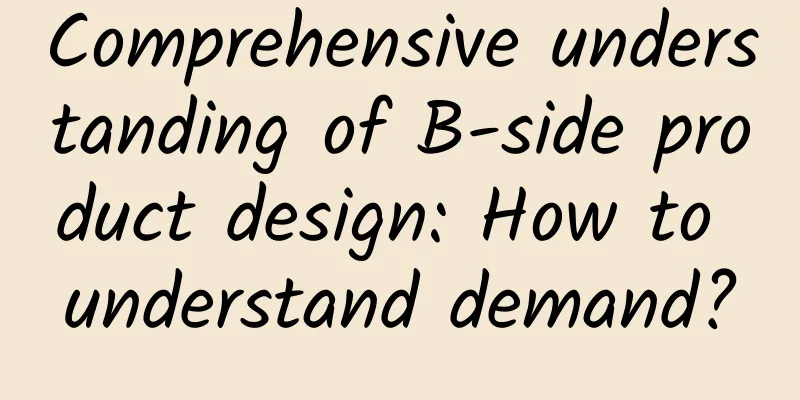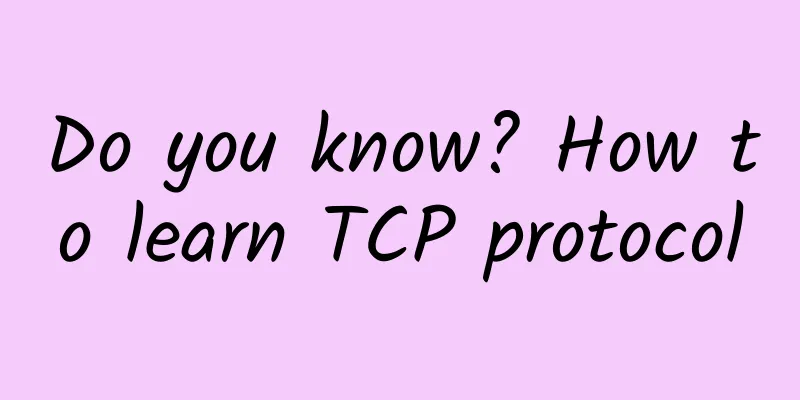Comprehensive understanding of B-side product design: How to understand demand?

|
In the previous article "Comprehensive Understanding of B-End Product Design: Basic Literacy", we already know that the difficulty of B-end design does not lie in exquisite appearance and complex design, but in meeting the actual needs of the product and effectively improving the efficiency of business operations.
So the biggest challenge for B-side designers is actually to understand the needs. Only with a clear understanding of the requirements can we identify the problems to be solved through design and provide conditions for giving the correct design. If the understanding of the requirements is vague or wrong, no matter how hard you try, you can only make a wrong design, and there will be a lot of rejections, wasting the team's time. So in this article, let’s talk about how we should understand B-side needs. Recognize business needs In B-side projects, the main source of requirements for designers is the product manager's requirements document or prototype. Of course, in some special cases, it may be the boss or customer's verbal description. Regardless of the form, the demand for B-end products is derived from the needs of the business. For example, on an e-commerce platform, only clothing products were originally sold, but as the business developed, new categories of shoes and boots were introduced. Then the original product creation process needs to be adjusted, such as adding the following requirements:
Therefore, the demand for B-side products is formulated because of business needs, rather than the product manager imagining something out of thin air and thinking that this function is great and users will definitely like it and then just implement it directly. So how can a designer who knows nothing about business analyze the company's business related to product needs? You can solve it through the following steps: Identify business goals For the daily operation of the enterprise, each business line consumes human costs and forms expenditures, so when formulating it, our expectation should be that it can bring benefits to the enterprise, although sometimes this benefit is not direct profit. The first step is to put aside all the details of the business and find out the goals and expectations it wants to achieve. For example, the goal of adding a new product line mentioned above is to expand the sales category to meet customer needs and increase revenue. Of course, some relatively large goals are easy to understand and seem clear, but it is far from enough to understand the business by just coming to this conclusion. Whether it is a company or an individual, a long-term goal must be composed of several small goals, that is, the conditions for achieving this result. Therefore, we also need to find out other goals to achieve this goal. This is a difficult task, because it involves many business issues. Therefore, you must understand that most of the time you cannot get the answer by just thinking on your own. What we should do is to consult colleagues who understand or are familiar with this business. We must be purposeful and proactive in understanding, rather than waiting for others to explain it to you one by one. Then, we need to connect the conclusions obtained using notes or mind mapping software to analyze the completeness of this business goal, such as the following figure: This is a simplified business goal breakdown that I have made. In real projects, it is often more complicated than this, and we can further break it down according to some very important secondary goals. This depends on everyone's judgment of the business. Once you have done all of this, you will have a clear understanding of the business content related to the current product. Even if it is an industry you have never been exposed to, you can use this method to gain a macro-level understanding. Draw business process diagram Next, we need to move from concept to practice, that is, the specific implementation method of the company in achieving these goals. Some students may have come into contact with product flow charts. Business flow charts are similar to them, that is, a series of practices to achieve the target results. However, unlike product flow charts, the execution process of business flow charts is more "linear" and does not need to show too many Booleans and loops. For example, if we analyze the correct product selection, then in the entire chain of determining the film selection, its execution steps are as follows: Similarly, we can also draw flowcharts for other goals in this way. The reason why we don’t draw the entire business process in one diagram is that too many steps will make the flowchart extremely difficult to read, and the execution of different goals does not necessarily have a strong correlation or sequence, so it is more reasonable to split it. It is crucial to master this content, because in the future when we understand the specific needs of the product and formulate the interaction process, we must associate it with the business process. It should also be noted that if time is insufficient and drawing and maintaining these graphics requires a lot of time, then I suggest using a note-taking tool like MarkDown to record directly to improve efficiency and not be bound by the word "graphics". Summarize the roles In all business practices, except for some automated equipment and procedures, the main body is people. However, people are assigned to different positions, with different permissions and responsibilities, so we can define the classification of "roles" for all members involved in the business. For example, in the previous process case, the execution from confirming product selection to screening target products is all handled by the product operations staff. When it comes to the review stage, other roles such as marketing, directors, and bosses will be involved. Submitting a purchase order also involves finance, and the final acceptance into the warehouse is completed by the warehouse manager. We not only need to find out the events that the roles correspond to in the business process, but also determine the role they play in this event. In my past production habits, I like to make the role into a symbol, then add it to the flowchart and mark it accordingly, as shown in the following figure: This approach can further reduce the complexity of organizing materials, making them easy for us to understand and share even when discussing within the team. Find out the pros and cons Finally, we need to summarize what we have done. Here, we need to find out the advantages and disadvantages, not to reflect on optimizing business processes like professional managers. This is beyond our scope of responsibility and beyond the vision and experience of designers. Although we want to find out the advantages and disadvantages, what we actually need to do is to discover the problems within the current process system. So what are the shortcomings of the process? In addition to our own imagination, we must also take the initiative to observe and communicate. The relevant roles in each event have the clearest feelings about the current problems, and we need to consult with them to ultimately perfect all conclusions. For example, when product operations analyze user reviews, the current background review list lacks filtering functions and cannot be exported to Excel. The results need to be recorded manually by turning pages, which is very time-consuming. This shortcoming will then evolve into one of the product requirements. In this way, we can mark the steps in the business where obvious problems occur, which is also done by marking on the flowchart. Of course, many times the product requirements we receive will include analysis of business problems, and we also need to directly link them to business processes, where the specific processing location is and which roles are involved. After completing this step, our understanding of the business will change qualitatively. At this point, we can use our own perspective to judge whether the current product meets our actual needs, and what kind of problems the interaction and design we are going to do next is solving, and how it will help achieve the overall goal. Summarize Although these contents may seem troublesome, you will definitely benefit a lot if you try them once. Especially for designers who have no idea about the problems solved by the current product and the company's business content, and only know how to draw according to the product prototype drawings, I believe that after you try it once, you will no longer feel confused about your current work. |
<<: iPhone Pro + Apple Pencil, is Apple going to slap Steve Jobs in the face this year?
>>: Where do old iPhone parts go? Apple may be using them to build new phones
Recommend
Operation and promotion: How should a novice write an operation plan?
When they first enter the workplace, many newcome...
Apple releases OS X 10.10.5 beta 3 to developers
Apple today released the third beta of OS X 10.10...
In-depth analysis | How to effectively control promotion costs and improve ROI
Search engine marketing has been carried out in m...
Four Seasons Health Diet Therapy Course
Four Seasons Health Diet Therapy Course Resource ...
Recommend several useful Linux e-book readers (Part 1)
With the increasing number of handheld devices, p...
Qingjue "Layout Design All-Round Special Training Class"
Course Catalog ├──Material | └──Material.7z 762.0...
Guike Zhihu live streaming camp, 0 basics to help you earn 20,000 a month
Guike Zhihu Sales Practice Camp will help you ear...
Aiti Tribe Stories (9): A Female Programmer's Development Dream
[51CTO.com original article] Xiao Bao is a straig...
Beware! A pen contains ten kinds of poisons. Your children may also be using it...
This article was reviewed by Chu Yuhao, PhD from ...
Are you still worried about the advertising materials for Moments? Here is a complete design specification!
1. Copywriting Copywriting is an important part o...
Snakes in the Year of the Snake | A land of women among snakes? Like hot springs? These snakes actually have special skills
In the Late Jurassic more than 100 million years ...
How to use Toutiao's recommendation rules to create a hit article with over 1 million readers? (10,000 words of dry goods)
Toutiao has been able to become a disruptor in th...
Unlock the creative advertising secrets that make your brand popular and popular!
This article begins with a study of cases with ex...
Cheese rhythm Han Yu short-term gold mining compulsory course
Cheese Rhythm Han Yu Short-term Gold Digging Comp...
Cooling down! Blizzard! Cold front is coming again
The cold air is coming again! November 19-22 Rain...









